|
Rudolf (21 August 1858 - 30 January 1889), archduke of Austria and crown prince of Austria, Hungary and Bohemia, was the son and heir of Franz Joseph I, emperor of Austria, Hungary and Bohemia, and his wife and empress, Elisabeth. His death, apparently through suicide, along with that of his mistress, Baroness Mary Vetsera, at his Mayerling hunting lodge in 1889 made international headlines, fueled international conspiracy rumours and ultimately may have sealed the long-term fate of the Habsburg monarchy.
Background

The young crown prince Rudolf during his adolescence
Archduke Rudolf Franz Karl Joseph (later Crown Prince) was born on 21 August 1858 in Schloss Laxenburg,[1] a castle near Vienna, as the son of Emperor Franz Joseph I and Empress Elisabeth. Influenced by his tutor Ferdinand von Hochstetter (who later became the first manager of the Imperial Natural History Museum), Rudolf became very interested in natural sciences, starting a mineral collection at a very early age.[1] (After his death, large portions of his mineral collection came into the possession of the University for Agriculture in Vienna.[1]).
Crown Prince Rudolf was raised together with his older sister Gisela by their paternal grandmother Archduchess Sophie. His parents' oldest child, a daughter named Sophie, died at the age of two before Rudolf was born, while younger sister Marie-Valerie was born ten years after Rudolf. Hence, Gisela and Rudolf grew up together and were very close. At the age of six, he was separated from his sister as he began his education to become a future Emperor. This did not change their relationship and Gisela remained close to him until she left Vienna upon her marriage to Prince Leopold of Bavaria. The siblings' parting was said to be very emotional.
Marriage
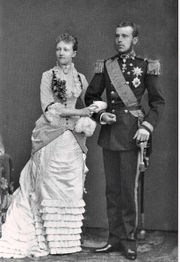
Official engagement photo of Crown Prince Rudolf and Princess Stéphanie of Belgium (1881)
In contrast with his deeply conservative father, Crown Prince Rudolf held distinctively liberal views that were closer to those of his mother. Nevertheless his relationship with her was strained and contained little warmth. In Vienna, on 10 May 1881, he married Princess Stéphanie of Belgium, a daughter of King Leopold II of the Belgians, in The Augustinian's Church in Vienna with all the pomp and splendour of a state wedding. Rudolf appeared to be genuinely in love, but his mother regarded her new daughter-in-law as a "clumsy oaf." By the time their only child, the Archduchess Elisabeth, was born on 2 September 1883, the couple had drifted apart, and he found solace in drink and other female companionship.
In 1887, Rudolf bought Mayerling and transformed it into a hunting lodge. In late 1888, the 30-year-old crown prince met the 17-year-old Baroness Marie Vetsera, known by the more fashionable Anglophile name Mary. From the start, Mary adored him, and was ready to do anything for him. It was almost certainly not the great romance of his life, but Rudolf did have feelings for her, and was touched by her limitless, almost fanatical, love for him.
Affairs and suicide
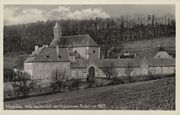
Mayerling lodge as it appeared when the crown prince killed himself there (before 1889)
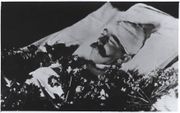
The crown prince lying-in-state. His head had to be bandaged in order to cover the self-inflicted gunshot wounds.
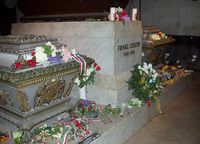
Crown Prince Rudolf (right) lies entombed next to his parents in the Imperial Crypt in Vienna.
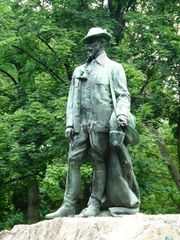
Statue in memory of the crown prince in the City Park of Budapest
According to official reports the deaths were a result of Franz Joseph's demand that the couple end the relationship: the Crown Prince, as part of a suicide pact, first shot his mistress in the head and then himself. Rudolf was officially declared to have been in a state of "mental unbalance" in order to enable burial in the Imperial Crypt (Kapuzinergruft) of the Capuchin Church in Vienna. Mary's body was smuggled out of Mayerling in the middle of the night and secretly buried in the village cemetery at Heiligenkreuz. After their deaths the Emperor had Mayerling converted into a penitential convent of Carmelite nuns. Today prayers are still said daily by the nuns for the repose of Rudolf's soul.
Impact of Rudolf's death
Following Rudolf's death, the marriage of his parents collapsed completely, with his mother spending much of her time abroad up until her own murder nine years later.
Next in the line of succession after Rudolf to the Austrian, Bohemian, and Hungarian thrones was Archduke Karl Ludwig, Franz Joseph's younger brother. Karl Ludwig renounced his succession rights a few days after Rudolf’s death, meaning his oldest son, Archduke Franz Ferdinand became heir presumptive.[2] Franz Ferdinand's assassination in 1914 sparked a chain of events that led directly to World War I. When Franz Joseph died in 1916, the throne passed to his grandnephew, Archduke Karl, who became the last Austro-Hungarian monarch as Emperor Karl of Austria.
Film and Theatre
- Crown Prince Rudolph, TV film directed by Robert Dornhelm (2006) in two parts. Historical adviser: Brigitte Hamann. Here, the love story and the conflict between father and son are embedded in the general political situation of the time in Central Europe.
- Frank Wildhorn's new musical Rudolf centers around Crown Prince Rudolf. It premiered at the Operetta Theatre in Budapest in 2006 and ran for three years. The Vienna production opened 26 February 2009 at the Raimund Theater.
- In The Illusionist (2006), a central character is the fictitious "Crown Prince Leopold," son of the Emperor Francis Joseph of Austria. In the film, "Leopold" commits suicide after a failing in a plot to overthrow his father and (apparently) murdering his fiancée. However, Prince Leopold is portrayed as right-wing and an autocratic absolutist who often complains of "mongrels."
- Kenneth MacMillan's 1978 ballet, Mayerling
- Miklós Jancsó's 1975 film Vizi Privati, Publiche Virtù (Private Vices, Public Virtues) is a daring reinterpretation of the Mayerling incident, in which the lovers and their friends are murdered by imperial authorities for plotting the Emperor's overthrow and for gross immorality and Mary Vetsera was portrayed as a hermaphrodite, which has no basis in history. The film was denounced by some critics as gratuitously graphic, but the director's point is how the decay and hypocrisy of the empire was reflected in the prince's desperately aberrant behavior.
- Requiem for a Crown Prince, fourth episode of the British documentary/drama series Fall of Eagles (1974), about the collapse of the Romanov, Habsburg and Hohenzollern dynasties. Directed by James Furman and written by David Turner, the 60-minute episode tracks in detail the events of Wednesday 30 January 1889, at Mayerling as well as the following few days - The discovery of the dead bodies, the breaking of news to Rudolf's family, the desperate attempts to cover up what really happened - even to the Emperor and Empress - and the secret smuggling of Marie Vetsera's body away from Mayerling before scandal can erupt.
- Mayerling (1968 film), starring Omar Sharif as Crown Prince Rudolf, Catherine Deneuve as Mary.
- The musical Marinka (1945), book by George Marion, Jr., and Karl Farkas, lyrics by George Marion, Jr., music by Emmerich Kalman
- De Mayerling à Sarajevo (1940 film), director Max Ophuls. The film starts with Rudolf's death.
- Mayerling, is a black and white dramatization based on the novel by Claude Anet. It is directed by Anatole Litvak and stars Charles Boyer as Crown Prince Rudolf and Danielle Darrieux as Maria Vetsera.
- Japanese Takarazuka Revue's "Utakata no Koi"/"Ephemeral Love"(based on Mayerling) revolves around Rudolph and Marie Vetsera.
- Rudolf also appears as a character in the musical Elisabeth and in Lillie, Grenada TV's dramatisation of the life of Victorian society beauty, Lillie Langtry.
Ancestors
| Ancestors of Rudolf, Crown Prince of Austria |
|
|
|
|
|
|
|
|
|
|
|
|
|
|
|
|
|
|
|
|
|
16. Leopold II, Holy Roman Emperor |
|
|
|
|
|
|
|
|
|
|
|
8. Francis II, Holy Roman Emperor |
|
|
|
|
|
|
|
|
|
|
|
|
|
|
|
17. Infanta Maria Louisa of Spain |
|
|
|
|
|
|
|
|
|
|
|
4. Archduke Franz Karl of Austria |
|
|
|
|
|
|
|
|
|
|
|
|
|
|
|
|
|
|
18. Ferdinand I of the Two Sicilies |
|
|
|
|
|
|
|
|
|
|
|
9. Princess Maria Teresa of the Two Sicilies |
|
|
|
|
|
|
|
|
|
|
|
|
|
|
|
19. Archduchess Maria Carolina of Austria |
|
|
|
|
|
|
|
|
|
|
|
2. Franz Joseph I |
|
|
|
|
|
|
|
|
|
|
|
|
|
|
|
|
|
|
|
|
|
20. Count Palatine Frederick Michael of Zweibrücken |
|
|
|
|
|
|
|
|
|
|
|
10. Maximilian I Joseph of Bavaria |
|
|
|
|
|
|
|
|
|
|
|
|
|
|
|
21. Countess Palatine Maria Franziska of Sulzbach |
|
|
|
|
|
|
|
|
|
|
|
5. Princess Sophie of Bavaria |
|
|
|
|
|
|
|
|
|
|
|
|
|
|
|
|
|
|
22. Margrave Charles Louis of Baden |
|
|
|
|
|
|
|
|
|
|
|
11. Princess Caroline of Baden |
|
|
|
|
|
|
|
|
|
|
|
|
|
|
|
23. Landgravine Amalie of Hesse-Darmstadt |
|
|
|
|
|
|
|
|
|
|
|
1. Rudolf, Crown Prince
of Austria |
|
|
|
|
|
|
|
|
|
|
|
|
|
|
|
|
|
|
|
|
|
|
|
|
24. Duke Wilhelm in Bavaria |
|
|
|
|
|
|
|
|
|
|
|
12. Duke Pius August in Bavaria |
|
|
|
|
|
|
|
|
|
|
|
|
|
|
|
25. Marie Anna of Zweibrücken-Birkenfeld |
|
|
|
|
|
|
|
|
|
|
|
6. Maximilian Joseph, Duke in Bavaria |
|
|
|
|
|
|
|
|
|
|
|
|
|
|
|
|
|
|
26. Duke Ludwig Maria of Arenberg |
|
|
|
|
|
|
|
|
|
|
|
13. Princess Amélie Louise of Arenberg |
|
|
|
|
|
|
|
|
|
|
|
|
|
|
|
27. Anne de Mailly-Nesle |
|
|
|
|
|
|
|
|
|
|
|
3. Empress Elisabeth |
|
|
|
|
|
|
|
|
|
|
|
|
|
|
|
|
|
|
|
|
|
28. Count Palatine Frederick Michael of Zweibrücken (= 20) |
|
|
|
|
|
|
|
|
|
|
|
14. Maximilian I Joseph of Bavaria (= 10) |
|
|
|
|
|
|
|
|
|
|
|
|
|
|
|
29. Countess Palatine Maria Franziska of Sulzbach (= 21) |
|
|
|
|
|
|
|
|
|
|
|
7. Princess Ludovika of Bavaria |
|
|
|
|
|
|
|
|
|
|
|
|
|
|
|
|
|
|
30. Margrave Charles Louis of Baden (= 22) |
|
|
|
|
|
|
|
|
|
|
|
15. Princess Caroline of Baden (= 11) |
|
|
|
|
|
|
|
|
|
|
|
|
|
|
|
31. Landgravine Amalie of Hesse-Darmstadt (= 23) |
|
|
|
|
|
|
|
|
|
|
Further reading
Austrian Royalty
House of Habsburg-Lorraine
|
|
|
Francis I
(Francis II, Holy Roman Emperor) |
| Children include |
| Archduchess Marie Louise |
| Ferdinand I |
| Archduchess Maria Leopoldina |
| Archduchess Clementina |
| Archduke Franz Karl |
| Grandchildren include |
| Franz Joseph I |
| Archduke Maximilian |
| Archduke Karl Ludwig |
| Archduke Ludwig Viktor |
| Great-grandchildren include |
| Archduke Franz Ferdinand |
| Archduke Otto Franz |
| Ferdinand I |
| Franz Joseph I |
| Children |
| Archduchess Sophie |
| Archduchess Gisela |
| Crown Prince Rudolf |
| Archduchess Marie Valerie |
| Grandchildren include |
| Archduchess Elisabeth Marie |
| Charles I |
| Children include |
| Crown Prince Otto |
| Archduke Robert |
| Archduke Felix |
| Archduke Karl Ludwig |
| Archduke Rudolf |
| Grandchildren include |
| Archduchess Andrea |
| Archduchess Monika |
| Archduchess Michaela |
| Archduchess Gabriela |
| Archduchess Walburga |
| Archduke Karl |
| Archduke Georg |
| Archduke Lorenz |
| Great-Grandchildren include |
| Archduke Ferdinand Zvonimir |
| Archduke Amedeo |
|
- Rudolf, Crown Prince of Austria. Majestät, ich warne Sie... Geheime und private Schriften. Edited by Brigitte Hamann. Wien: Amalthea, 1979, ISBN 3-85002-110-6 (reprinted München: Piper, 1998, ISBN 3-492-20824-X).
- Barkeley, Richard. The Road to Mayerling: Life and Death of Crown Prince Rudolph of Austria. London: Macmillan, 1958.
- Franzel, Emil. Crown Prince Rudolph and the Mayerling Tragedy: Fact and Fiction. Vienna : V. Herold, 1974.
- Hamann, Brigitte. Kronprinz Rudolf: Ein Leben. Wien: Amalthea, 2005, ISBN 3-85002-540-3.
- Listowel, Judith Márffy-Mantuano Hare, Countess of. A Habsburg Tragedy: Crown Prince Rudolf. London: Ascent Books, 1978.
- Lonyay, Károly. Rudolph: The Tragedy of Mayerling. New York: Scribner, 1949.
- Salvendy, John T. Royal Rebel: A Psychological Portrait of Crown Prince Rudolf of Austria-Hungary. Lanham, MD: University Press of America, 1988.
- Morton, Frederic. A Nervous Splendor: Vienna 1888/1889. Penguin 1979
See also
- Baroness Mary Vetsera
- Lake Rudolf
- Mayerling Incident
- Rudolf Island
- List of heirs to the Austrian throne
Notes
External links
|
Austrian archdukes |
|
| 1st Generation |
|
|
| 2nd Generation |
Archduke Cristopher · Maximilian I · Archduke John · Archduke Wolfgang
|
|
| 3rd Generation |
|
|
| 4th Generation |
|
|
| 5th Generation |
|
|
| 6th Generation |
Charles, Prince of Asturias* · Archduke Ferdinand · Rudolf V · Archduke Ernest · Matthias · Maximilian III · Albert VII · Archduke Wenzel · Archduke Frederick · Archduke Charles · Ferdinand, Prince of Asturias* · Archduke Ferdinand · Archduke Carlos Lorenzo* · Diego, Prince of Asturias* · Philip III of Spain* · Ferdinand III · Archduke Charles · Archduke Maximilian Ernest · Leopold V · Archduke Charles
|
|
| 7th Generation |
Archduke Charles · Philip IV of Spain* · Archduke Philipp · Archduke John-Charles · Archduke Albert · Archduke Charles* · Ferdinand IV · Archduke Ferdinand* · Archduke Alfonso Mauricio · Leopold Wilhelm · Ferdinand Charles · Sigismund Francis
|
|
| 8th Generation |
Balthasar Charles, Prince of Asturias* · Ferdinand IV of Hungary · Archduke Francisco Fernando* · Archduke Philip August · Archduke Maximilian Thomas · Leopold VI · Archduke Charles Joseph · Archduke Ferdinand Joseph Alois · Philip Prospero, Prince of Asturias* · Archduke Ferdinand Thomas* · Charles II of Spain*
|
|
| 9th Generation |
Archduke Ferdinand Wenzel · Archduke John Leopold · Joseph I · Archduke Leopold Joseph · Charles III
|
|
| 10th Generation |
Archduke Leopold Joseph · Archduke Leopold John
|
|
| 11th Generation |
Joseph II** · Archduke Charles Louis** · Leopold VII** · Archduke Ferdinand** · Maximilian Franz, Archbishop-Elector of Cologne**
|
|
| 12th Generation |
Emperor Francis I** · Ferdinand III, Grand Duke of Tuscany** · Charles, Duke of Teschen** · Alexander Leopold, Palatine of Hungary** · Joseph, Palatine of Hungary** · Archduke Anton Victor** · Archduke John** · Archduke Rainier Joseph** · Archduke Louis** · Cardinal-Archduke Rudolf** · Archduke Josef Franz*** · Francis IV, Duke of Modena*** · Archduke Ferdinand Karl Joseph*** · Archduke Maximilian*** · Karl, Primate of Hungary***
|
|
| 13th Generation |
Emperor Ferdinand I · Francis Leopold, Grand Prince of Tuscany** · Leopold II, Grand Duke of Tuscany** · Archduke Joseph Franz · Archduke Franz Karl · Archduke Johann Nepomuk · Albert, Duke of Teschen · Stephen, Palatine of Hungary · Archduke Karl Ferdinand · Francis V, Duke of Modena*** · Archduke Frederick Ferdinand · Archduke Ferdinand Karl Viktor*** · Archduke Rudolf · Archduke Leopold Ludwig · Archduke Ernest Karl · Archduke Alexander · Archduke Sigismund Leopold · Archduke Rainer Ferdinand · Archduke Wilhelm Franz · Archduke Heinrich Anton · Archduke Maximilian Karl · Archduke Joseph Karl
|
|
| 14th Generation |
Emperor Franz Joseph I · Maximilian I of Mexico · Archduke Charles Louis · Archduke Ludwig Viktor · Ferdinand IV, Grand Duke of Tuscany** · Archduke Karl Salvator** · Archduke Rainier** · Archduke Ludwig Salvator** · Archduke John Salvator** · Archduke Karl · Archduke Franz Joseph · Friedrich, Duke of Teschen · Archduke Charles Stephen · Archduke Eugen · Archduke Joseph August · Archduke Ladislaus
|
|
| 15th Generation |
Crown Prince Rudolf · Archduke Franz Ferdinand*** · Archduke Otto Francis · Archduke Ferdinand Karl · Archduke Leopold Ferdinand** · Archduke Joseph Ferdinand** · Archduke Peter Ferdinand** · Archduke Heinrich Ferdinand** · Archduke Robert Ferdinand** · Archduke Leopold Salvator** · Archduke Franz Salvator** · Archduke Albrecht Salvator** · Archduke Rainier Salvator** · Archduke Ferdinand Salvator** · Albrecht Franz, Duke of Teschen · Archduke Karl Albrecht · Archduke Leo Karl · Archduke Wilhelm · Archduke Joseph Francis · Archduke Ladislaus Joseph · Archduke Matthias
|
|
| 16th Generation |
Emperor Charles I · Archduke Maximilian Eugen · Archduke Gottfried** · Archduke Georg** · Archduke Rainier** · Archduke Leopold Maria** · Archduke Anton** · Archduke Franz Joseph** · Archduke Karl Pius** · Archduke Franz Karl** · Archduke Hubert Salvator** · Archduke Theodor Salvator** · Archduke Clemens Salvator** · Archduke Joseph Arpád · Archduke Itsván · Archduke Géza · Archduke Michael Koloman
|
|
| 17th Generation |
Crown Prince Otto · Archduke Robert*** · Archduke Felix · Archduke Carl Ludwig · Archduke Rudolf · Archduke Ferdinand Karl · Archduke Heinrich Maria · Archduke Leopold Franz** · Archduke Guntram** · Archduke Radbot** · Archduke Johann** · Archduke Georg** · Archduke Stephan** · Archduke Dominic** · Archduke Friederich Salvator** · Archduke Andreas Salvator** · Archduke Markus** · Archduke Johann** · Archduke Michael** · Archduke Franz Salvator** · Archduke Karl Salvator** · Archduke Joseph Karl · Archduke Andreas Agustinus · Archduke Nicholas Franz · Archduke Johann Jacob · Archduke Edward Karl · Archduke Paul Rudolf
|
|
| 18th Generation |
Archduke Karl · Archduke Georg · Archduke Lorenz*** · Archduke Gerhard*** · Archduke Martin*** · Archduke Karl Philipp · Archduke Raimund Joseph · Archduke Itsván · Archduke Rudolf · Archduke Carl Christian · Archduke Karl Peter · Archduke Simeon · Archduke Johannes · Archduke Maximilian Heinrich · Archduke Philipp Joachim · Archduke Ferdinand Karl · Archduke Konrad · Archduke Sigismund** · Archduke Georg** · Archduke Guntram** · Archduke Leopold** · Archduke Alexander Salvator** · Archduke Thaddäus Salvator** · Archduke Casimir Salvator** · Archduke Matthias** · Archduke Johannes** · Archduke Bernhard** · Archduke Benedikt · Archduke Joseph Albrecht · Archduke Paul Leo · Archduke Friedrich Cyprian · Archduke Benedikt Alexander · Archduke Nicolás · Archduke Santiago · Archduke Paul Benedikt
|
|
| 19th Generation |
Archduke Ferdinand Zvonimir · Archduke Karl Konstantin · Archduke Amedeo*** · Archduke Joachim*** · Archduke Bartholomaeus*** · Archduke Emmanuel*** · Archduke Felix Carl · Archduke Andreas Franz · Archduke Paul Johannes · Archduke Carl Christian · Archduke Johannes · Archduke Thomas · Archduke Franz Ludwig · Archduke Michael · Archduke Joseph · Archduke Imre · Archduke Imre · Archduke Christoph · Archduke Alexander · Archduke Lorenz Carl · Archduke Wilhelm · Archduke Johannes · Archduke Ludwig · Archduke Philipp · Archduke Nicholas · Archduke Constantin · Archduke Jacob Maximilian · Archduke Leopold Amedeo** · Archduke Maximilian** · Archduke Leopold** · Archduke Constantin Salvator** · Archduke Paul Salvator**
|
|
*also an infante of Spain
**also a prince of Tuscany
***also a prince of Modena |
|
|






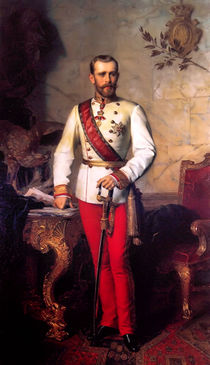
.png)